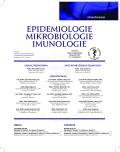Epidemiological significance of the metabolic syndrome
Authors:
D. Horáková; K. Azeem; L. Dumbrovská; J. Vlčková; V. Horák; H. Kollárová
Authors‘ workplace:
Ústav preventivního lékařství LF UP Olomouc
Published in:
Epidemiol. Mikrobiol. Imunol. 65, 2016, č. 4, s. 215-218
Category:
Review Article
Overview
From an epidemiological point of view, the metabolic syndrome is a group of risk factors causally, rather than coincidentally, related to insulin resistance. The metabolic syndrome is a condition with relatively high prevalence rates in both the Czech Republic and in other developed countries. There is a clear trend of increasing prevalence in both sexes depending on age. In the Czech Republic, the syndrome is less common in females (25.5%) than in males (37.6%). Epidemiological studies found white (Europoid race) males to be at higher risk due to abdominal obesity. The definition of the metabolic syndrome has evolved over time and helps to identify individuals at high risk of developing cardiovascular disease and type 2 diabetes, hence the use of the term cardiometabolic syndrome. Early detection of metabolic syndrome symptoms including insulin resistance should be performed mainly by general practitioners as part of regular check-ups.
KEYWORDS:
metabolic syndrome – prevalence – cardiovascular risk – type 2 diabetes mellitus – obesity
Sources
1. Reaven GM. Banting lecture 1988. Role of insulin resistance in human disease. Diabetes, 1988; 37(12): 1595–1607.
2. Kaplan NM. The deadly quartet. Upper-body obesity, glucose intolerance, hypertriglyceridemia, and hypertension. Arch Intern Med, 1989; 149(7): 1514–1520.
3. Hrnčiar J. Endokrinné choroby a hormonálne metabolické rizikove faktory ischemickej choroby srdca, Syndrom X-5H. Žilina: EPP; 1997.
4. Reaven GM. Role of insulin resistence in human disease (syndrome X): an expanded definition. Annu Rev Med, 1993; 44: 121–131.
5. Rosolová H a kol. Preventivní kardiologie v kostce. Praha: Axonite CZ; 2013: 108–158.
6. National Institutes of Health. Third report of the National Cholesterol Education Program (NCEP) Expert Panel on detection, evaluation and treatment of high blood cholesterol in adults (Adult treatment panel III). Washington DC: US Govt. Printing Office; 2001.
7. Alberti KG, Zimot P, Shaw J. Metabolic syndrome-a new world-wide definition. A Consensus Statement from the International Diabetes Federation. Diabet Med 2006; 23(5): 469–480.
8. Svačina Š. Poruchy metabolismu a výživy. Praha: Galen, 2010: 227–241.
9. Ibanez L, Sanzana R, Salas C, et al. Prevalence of metabolic syndrome in Mapuche individuals living in urban and rural enviroment in Chile. Rev Med Chill 2014; 142(8): 953–960.
10. Cameron AJ, Shaw JE, Zimmet PZ. The metabolic syndrome: prevalence in worldwide populations. Endocrinol Metab Clin N Am 2004; 33: 351–375.
11. Vieira EC, Peixoto MR, Silveira EA. Prevalence and factors associated with metabolic syndrome in elderly user sof the unified health systém. Rev Bras Epidemiol 2014; 17(4): 805–817.
12. Cífková R, Škodová Z, Bruthans J. Longitudinal trends in the prevalence of the metabolic syndrome in the Czech population from 1997–8 to 2006–9. The Czech post-MONICA Study. Abstract for the Conference of ECRP, Prague 2010.
13. Vosátková M, Čeřovská J, Zamrazilová H, et al. Prevalence of obesity and metabolic syndrome in adult population of selected regions of the Czech Republic. Relation to rating habits and smoking. Prague Medical Report 2012; 113(3): 206–216.
14. Horáková D, Čížek L, Koutná J, et al. Posouzení frekvence výskytu metabolického syndromu. Časopis lékařů českých 2005; 144: 478–481.
15. Sanchez HB, Harhay MO, Harhay MM, et al. Prevalence and trends of metabolic syndrome in the adult US population, 1999–2010. J Am Coll Cardiol 2013; 62(8): 697–703.
16. Pastucha D, Filipčíková R, Horáková D, et al. Evaluation of insulin resistance and metabolic syndrome in a group of obese Czech children. J Pediatr Endocrinol Metab 2014; 27(7–8): 651–656.
17. Kopecký M. Prevalence nadměrné hmotnosti a obezity u 6–7letých dětí a postoj rodičů k primární prevenci v Olomouckém kraji. Hygiena 2016; 61(1): 4–10.
18. Medina-Vera I, Serralde-Zuniga AE, Islas-Ortega L, et al. Diagnosis of metabolic syndrome in children as a potential indicator of technical ability in medici and nutritional care. Nutr Hosp 2015; 32: 2105–2110.
19. Fadzlina A, Harun F, Nurul Haniza M, et al. Metabolic syndrome among 13 year old adolescents: prevalence and risk factors. BMC Public Health 2014; 14 Suppl 3: S7.
20. Aldhoon-Hainerová I, Zamrazilová H, Dušátková L, et al. Glucose homeostasis and insulin resistence: prevalence, tender differences and predictors in adolescents. Diabetol Metab Syndr 2014; 6(1): 100.
21. Ben-Shmuel S, Rostoker R, Scheinman EJ, et al. Metabolic syndrome, type 2 diabetes, and cancer: Epidemiology and potential mechanisms. Handb Exp Pharmacol, 2015.
Labels
Hygiene and epidemiology Medical virology Clinical microbiologyArticle was published in
Epidemiology, Microbiology, Immunology

2016 Issue 4
Most read in this issue
- Prevalence of Mycoplasma hominis and Ureaplasma urealyticum in women undergoing an initial infertility evaluation
- IGRA methods in the routine operation – QuantiFERON®-TB Gold or T-SPOT.TB?
- Epidemiological significance of the metabolic syndrome
- Differential diagnosis of the viral etiology of suspected mumps in a population with high vaccine coverage
